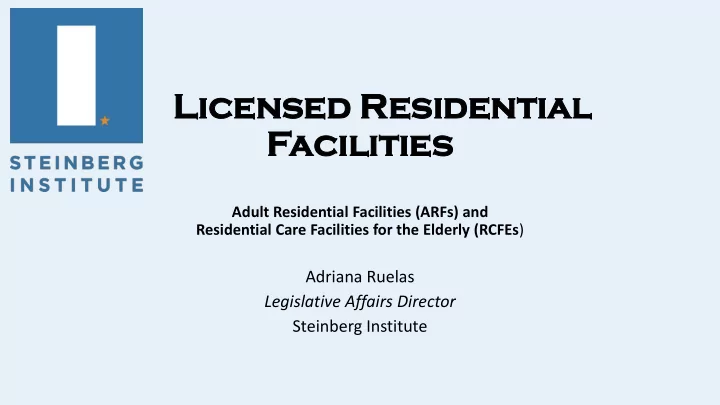

Li Licen censed sed Resi esiden dential tial Fac acilities ilities Adult Residential Facilities (ARFs) and Residential Care Facilities for the Elderly (RCFEs ) Adriana Ruelas Legislative Affairs Director Steinberg Institute
Adu dult lt Res esidenti idential al Facili cilities ties Fs ) (A (ARFs • “Board -and- care” • Age: 18 – 59 • Licensed by the Department of Social Services to provide care and services • Provides services that allow people to maintain independence and receive individualized care in a home-like environment, to include: • 24 Hour Care • Three meals/day (must accommodate special dietary needs) • Assistance with managing medications • Public Guardians utilize Board and Care’s as the least restrictive placement for Conservatees
Res esidenti idential al Car are e Facilities acilities for r the he Elde derl rly y (R (RCFEs) FEs) • Age: 60+ • Provide room, board, housekeeping, supervision, and personal care assistance with basic activities like personal hygiene, dressing, eating, and walking • Care and supervision for people who are unable to live by themselves but who do not need 24-hour nursing care
Statewide Closures • Housing values and minimum-wage continue to increase yet reimbursement rates have remained stagnant • No reliable data on the decrease in facilities* • Since 2012, San Francisco has lost more than a third of licensed residential facilities that serve people under 60, and more than a quarter of those serving older clients. (CALmatters) • Los Angeles, which has a large portion of the state’s board -and-cares, has lost more than 200 beds for low-income people with serious mental illness in the past year. (CALmatters) • Multiple board-and-care licenses currently under review with no approval guaranteed
Goa oals ls of of AB 1 B 1766 66 (Bl Bloo oom) ) Bo Board rd and Care re Da Data Collec llection tion and Not otific ification tion • Improving access and minimizing closures through… • Data collection, related to: • Acceptance rate of residents paying with Supplemental Security Income rate • Number of patients being served • Average length of stay • Facility type and by county • Bed capacity of each facility • Creating a pathway for resources while protecting privacy* • Collaboration and reporting between the state, counties and licensed facilities
Resource Pathway • Individual “No Place Like Home” grant awards identifying 20 percent of beds for those in need of long-term care to offset shortage • Increasing and working with facilities to accept and fill funding gap for SSI income recipients
“Transfer Trauma” & Relocation Stress • A facility closure can be especially traumatic for vulnerable clients • Re-entering the community and navigating the social services sector is daunting for those with serious mental disorder. • Residents at these facilities become confused and distraught • Particularly those who have lived at their board-and-care for more than five years
Identified Problems 1. Funding 2. Lack of knowledge – number of facilities 3. Availability and closure of facilities 4. Transfer trauma and relocation stress 5. LPS-Conservatorship placements- LPS Audit 6. Potential homelessness
Recommend
More recommend